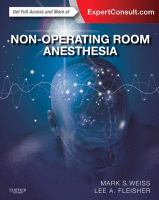Physical Address
304 North Cardinal St.
Dorchester Center, MA 02124

History of Anesthesia for Gastrointestinal Endoscopic Procedures Sedation and analgesia are common components to most upper and lower endoscopic procedures. Although diagnostic upper and lower endoscopy can be performed without sedation, the use of sedative medications improves patient comfort and…

Gastrointestinal (GI) endoscopies are among the most common non–operating room procedures requiring anesthesia. This chapter reviews considerations and challenges related to anesthesia for upper GI endoscopy procedures. These include esophagogastroduodenoscopy (EGD), endoscopic ultrasound (a variation on EGD employing a specialized…

As imaging technology improves, it is increasingly possible to perform procedures with noninvasive or minimally invasive techniques that would have once required an operating room. Specialized suites such as cardiac electrophysiology, interventional radiology, and radiation oncology have arisen to support…

Direct-current cardioversion is a common cardiological procedure, consisting of delivering an electric shock to the patient’s heart with the goal of restoring normal sinus rhythm. The common indication for the procedure is atrial fibrillation or flutter and less commonly other…

Acknowledgments The authors thank Drs. David Callans, Lee Fleisher, and Sean Kennedy for their comments on a draft of this chapter. In the electrophysiology laboratory, procedures are performed to diagnose and treat abnormal cardiac rhythms. These procedures can be accomplished…

The treatment of structural heart disease is undergoing a revolution reminiscent of the management of coronary artery disease 30 years ago—the development, evaluation, and application of catheter-based techniques of valve repair and replacement. Catheter deployed devices have also displaced surgical…

The preoperative evaluation of the patient undergoing anesthesia is both a requirement of the Centers for Medicare and Medicaid Services and important in preparing an anesthetic plan. Certain parts of the anesthesia preoperative evaluation are standard, whereas other elements are…

The provision of hospital-based, non–operating room anesthesia (NORA) has become a burgeoning part of almost every anesthesiology practice in the United States. Cost savings, facilitated scheduling (as opposed to in the main operating rooms), and increased patient satisfaction are just…

Acknowledgment Anil Gupta would like to thank the Department of Anaesthetics, Gisborne Hospital, Gisborne, New Zealand, for the time he was given during the nonclinical sessions, which gave him the opportunity to complete this chapter. The operating room is considered…

The rise in the number of nonsurgical diagnostic and therapeutic interventions is driving the surge in volume of remote anesthesia and sedation services. These procedures have simultaneously become increasingly complex as a result of technological advances and sicker patient cohorts.…